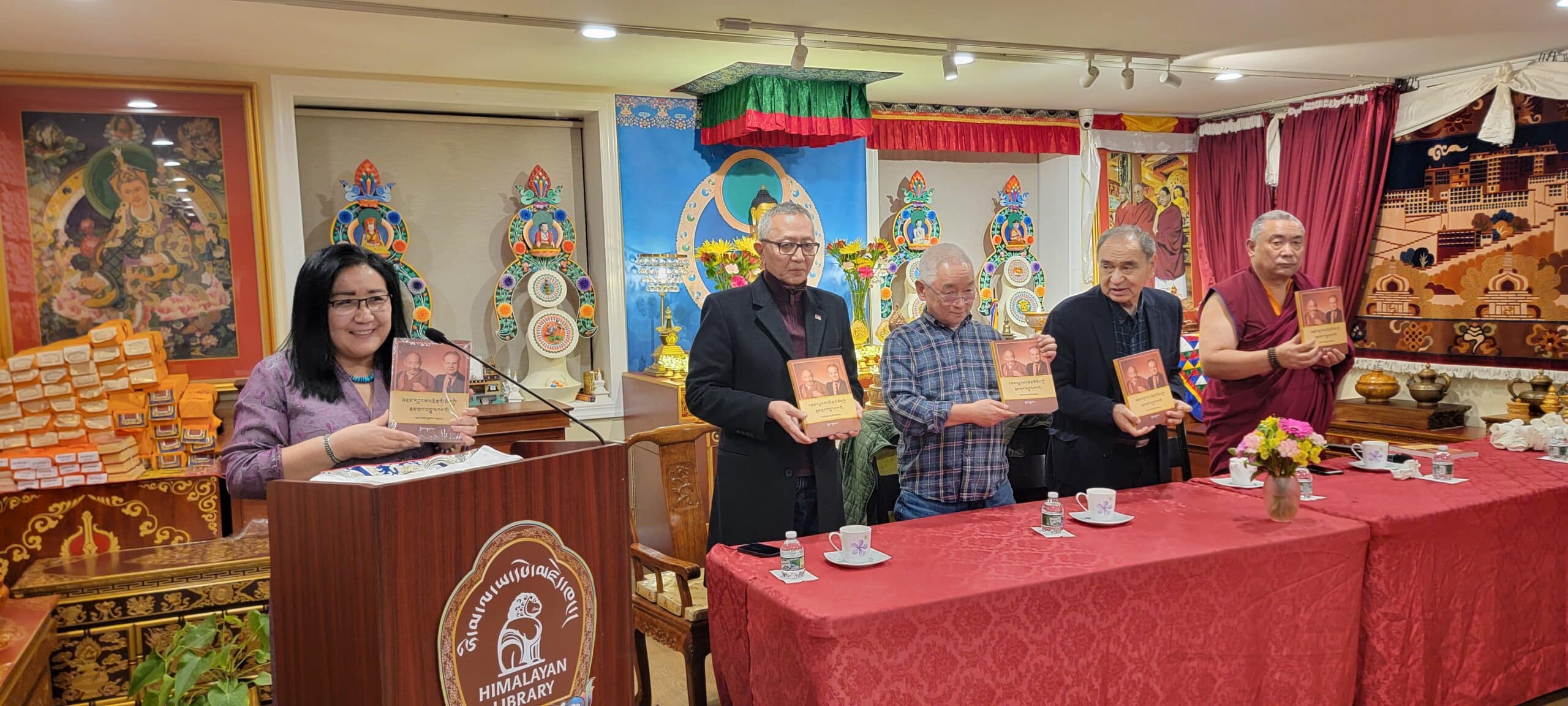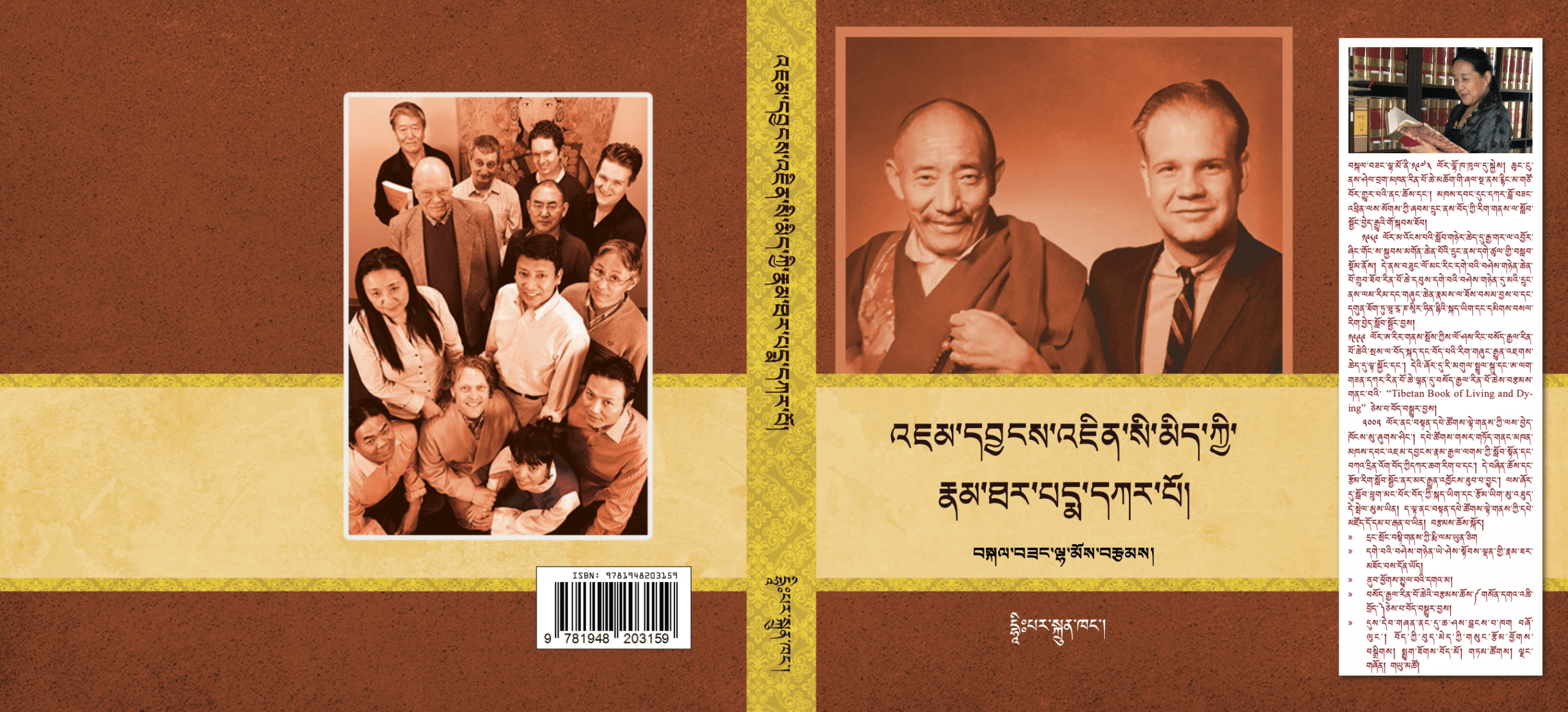
Kelsang Lhamo is joined by Kunga Tashi, Pema Bhum, Rinchen Dharlo, and Lama Tsewang at her book launch at Himalayan Library in New York City.
We are delighted to announce that BDRC Senior Librarian Kelsang Lhamo has published her long-awaited Tibetan language biography of our founder, and her mentor, Gene Smith.
Kelsang is not only a poet and writer with a highly respected body of work, she is also Gene's first full time hire. She worked closely with Gene from the earliest days as the Tibetan Buddhist Resource Center grew from a tiny outfit to the organization that it is today. The White Lotus Biography of Jamyang Gene Smith was launched at the Himalayan Library in New York City on March 11, 2023.
Kelsang wrote her chronicle of Gene because she felt that Gene's mission to preserve and share endangered Tibetan Buddhist texts deserves to be remembered for all time.

We are pleased to present an excerpt from the White Lotus Biography.
In 1965, at the major monasteries including Sera, Drepung, and Ganden, as well as others, there was a major problem of lack of Tibetan texts. Classes of hundreds of students only had one textbook amongst themselves to share and to memorize, turn by turn. Some students who were not as sharp even fell ill, from the stress of falling behind.
That year, with the help of a couple of rich hippies that he knew, Gene gathered scholars from Buxa Duar, from Sera, Drepung and Ganden, from all the major schools of Tibetan Buddhism, and met with them in Darjeeling at the the monastery of Drukpa Thuksay Rinpoche, (who was a close friend of Phuntsok Phodrang). With the scholars, he first started making lithographs of Tibetan texts followed by mimeographs and finally he began typewriting the texts to produce multiple reprints of the obligatory liturgical and philosophical texts. Later modern printing press facilities allowed them to make many copies of the texts and solved the problem of not having enough texts for the monks in each monastery.
At Rumtek, Gene was fortunate to have audiences with H.H. the Sixteenth Gyalwa Karmapa (1924-1981) from whom he received much guidance, advice and support for his preservation and printing initiative. H.H. the Karmapa was very kind and patient in responding to Gene's many questions.
Tai Situ Ripoche remembers that the H.H. the Sixteenth Gyalwa Karmapa would not tolerate any mistakes in printing the texts. 'Gyalwa Karmapa advised us to go to Gene for final editing when we were reprinting the Derge Kangyur, saying that Gene would spot even the tiniest of typos,' Situ Rinpoche told me during an audience. He smiled as he remembered the time.
While in Sikkim, Gene became great friends with the Sikkimese king Palden Dhondup Namgyal (1923-1982). Since both were highly interested in promoting education, they established the Namgyal Institute of Tibetology in 1964. It was said that during the day the two men engaged in advancement of education and intellectual vocations and at night when everyone was asleep, the two would enjoy drinks and talk about their lives. Although the king was a heroic figure, he lost his county to others, and died alone after even the queen and the princes left him. But in the hearts of the people of Sikkim, he always remained their Dharma King and his Namgyal Institute of Tibetology was a memento that he left them.
– Excerpted from The White Lotus Biography of Jamyang Gene Smith
1965 དེའི་ཚེ་གདན་ས་ཆེན་པོ་སེ་འབྲས་དགའ་གསུམ་གཙོས་པའི་སྐྱབས་བཅོལ་བའི་དགོན་སྡེ་ཁག་ལ་སློབ་གཉེར་བ་ཚོར་དཔེ་ཆའི་སྐུ་ངལ་ཧ་ཅང་ཕྲད་བཞིན་པ་ཡིན། འཛིན་གྲྭ་གཅིག་ལ་སློབ་གཉེར་བ་བརྒྱ་ཕྲག་བརྒལ་བར་མ་དཔེ་གཅིག་ལས་མེད་པས་སློབ་མ་ཚོས་ལྡེབ་མ་གཅིག་རེས་མོས་ཀྱི་བློ་འཛིན་དང་གཡོར་རེས་གནང་དགོས་ཁེལ་ཡོད། སྐབས་རེ་སློབ་མ་རིག་པ་སྐྱོ་བ་འགའ་ཞིག་ནི་བློ་འཛིན་མ་ཐུབ་པའི་སྐུ་ངལ་གྱིས་བསྙུན་པའང་མང་དུ་བྱུང་སྐད། (1965) ལོ་ནས་འཇིན་ལགས་ཀྱིས་ངོ་མཁྱེན་པའི་ནུབ་ཕྱོགས་པའི་ཕྱུག་འཁྱམས་འགའི་རོགས་ལམ་ལ་བརྟེན་ན། སྦག་ས་ཆོས་སྒར་ནས་གདན་ས་གསུམ་དང་། དེ་མིན་ཆོས་བརྒྱུད་ཁག་གི་མཁས་པ་རྣམས་བསྡུས་ནས་རྡོ་རྗེ་གླིང་དུ་འབྲུག་པ་ཐུགས་སྲས་རིན་པོ་ཆེའི་ཆོས་སྒར་དུ་རྡོ་པར་དང་སྣུམ་པར། དེ་ནས་རིམ་པར་ལྕགས་པར་སོགས་དང་མཐར་དེང་རབས་ཅན་གྱི་འཕྲུལ་པར་བར་མཁོ་སྤྲོད་གནང་ནས་གནས་སྐབས་སློབ་གཉེར་བ་ཚོར་ཁ་ཚ་དགོས་བཏུགས་ཀྱི་རང་རང་སོ་སོའི་ཆོས་བརྒྱུད་ཀྱི་ཡིག་ཆ་རྣམས་བསྐྱར་དུ་པར་སྐྲུན་གནང་བའི་ཐུགས་འགན་བཞེས་པས་རིང་པོར་མ་ཐོགས་པར་སློབ་གཉེར་བ་རྣམ་པའི་དཀའ་ངལ་ཆེ་ཤོས་དེ་སེལ་ཐུབ་པ་བྱུང་། འབྲུག་པ་ཐུགས་སྲས་ནི་ས་སྐྱ་ཕུན་ཚོགས་ཕོ་བྲང་གི་མཉེས་གཤིན་པའི་སྐུ་ཉེ་ཡིན་པས་འཇིན་སི་མིད་ལགས་ཀྱི་ལས་དོན་ལ་གང་ཅིར་བསྐུར་བསྟི་ཕུན་སུམ་ཚོགས་པ་བསྒྲུབས།
དེ་དུས་རུམ་སྟེགས་རྙིང་པར་དཔལ་རྒྱལ་དབང་ཀརྨ་པ་བཅུ་དྲུག་པ་ཆེན་པོའི་(1924-1981) ཞལ་མཇལ་གོ་སྐབས་ཐོབ་ཅིང་། བརླག་ལ་ཉེ་བའི་བོད་ཀྱི་ཤིང་པར་རྣམས་སླར་བསྐྱར་གསོ་གནང་རྒྱུའི་ཆེད་དུ་བཀའ་སློབ་དང་ལམ་སྟོན་འདྲི་བར་འོས་པ་དུ་མ་བཀའ་འདྲི་ཞུས་ཤིང་། དཔལ་རྒྱལ་དབང་ཆེན་པོས་ཀྱང་དེའི་ལན་ལྡོན་དུ་དགྱེས་བཞིན་ཐུགས་བརྩེ་བ་ཆེན་པོས་བསྟན་པ་དང་འགྲོ་བའི་དོན་དུ་སྨན་པའི་སྙིང་པོ་ཅན་གྱི་བཀའ་སློབ་མང་དུ་སྩལ། མི་རིང་བར་དཔལ་རྒྱལ་དབང་བཅུ་དྲུག་པ་ཆེན་པོས་ཀྱང་བཀའ་འགྱུར་སྡེ་དགེ་པར་ཕུད་བསྐྱར་པར་མཛད། ཏཱའི་སི་ཏུ་རིན་པོ་ཆེའི་ཞལ་ནས། ང་ཚོ་ན་གཞོན་སྐབས་དཔལ་རྒྱལ་དབང་ཀརྨ་པ་བཅུ་དྲུག་པ་ཆེན་པོའི་བཀའ་དགོངས་བཞིན་དུ་བཀའ་འགྱུར་སྡེ་དགེ་པར་ཕུད་བསྐྱར་དུ་ལྡི་ལིར་བསྐྱར་དུ་པར་བའི་དུས། ང་ཚོར་པར་རྩ་ཞུས་དག་གཏོང་བཅུག་གནང་གི་ཡོད། ཐ་མའི་ཞུས་དག་དེ་འཇིན་ལགས་ཀྱི་སར་ཕེབས་ནས་ཐག་གཅོད་དགོས། ནོར་འཁྲུལ་ཆུང་ངུ་ཙམ་ཡང་ཁོང་གིས་གཟིགས་མ་ཐག་མཁྱེན་ཅིང་། དྲག་ཞན་མཐོ་དམན་སུ་ཡིན་རུང་ནོར་འཁྲུལ་ཅུང་ཟད་ཁོང་གི་དྲུང་དུ་འགྲོ་ས་མེད་པས་བཀའ་བསྐྱོན་མང་པོ་བཟེད་མྱོང་། ཞེས་བཞད་མོ་དང་བཅས་སྤྱི་ལོ་ (2014) ལོར་ཨ་རིར་ཆིབ་བསྒྱུར་སྐབས་བདག་ལ་མཇལ་ཁའི་སྐབས་སུ་ནང་མོལ་དུ་གསུངས།
དེའི་ཚེ་གཏམ་བརྒྱུད་སྙན་པོ་གཞན་ཞིག་ཀྱང་ཡོད་པ་ནི། འཇིན་ལགས་དང་འབྲས་ལྗོངས་རྒྱལ་རབས་བཅུ་གཉིས་པ་རྒྱལ་པོ་དཔལ་ལྡན་དོན་གྲུབ་རྣམ་རྒྱལ་ (1923-1982) ཟུང་གྲོགས་ཆེན་དུ་གྱུར་ཅིང་གཉིས་ཀའི་རྣམ་པར་དཀར་བའི་ཐུགས་བསྐྱེད་ལས་རུམ་སྟེགས་སུ་ཤེས་ཡོན་ཅན་དང་ཤེས་ཡོན་ཅན་གསོ་སྐྱོང་གི་ཆེད་དུ་རྣམ་རྒྱལ་བོད་ཀྱི་ཤེས་རིག་ཉམས་ཞིབ་ཁང་། ཞེས་པ་གསར་དུ་བཙུགས། དེ་ཡང་ (1964) ལོ་ནས་ཆོས་རྒྱལ་གྱི་ཐུགས་བསྐྱེད་ཇི་ལྟ་བ་བཞིན་དུ་ (1965) ལོར་འཇིན་སི་མིད་ལགས་ཀྱི་བློ་གྲོས་ལ་བརྟེན་ནས་དངོས་སུ་ལེགས་གྲུབ་བྱུང་། ཆོས་རྒྱལ་མཆོག་དང་འཇིན་ལགས་རྣམ་གཉིས་ཕན་ཚུན་ཐུགས་གཤིས་ཧ་ཅང་མཐུན། ཉིན་མོ་ཤེས་རིག་སྐོར་གྱི་ཕྱག་ལས་གནང་བ་དང་། དགོང་དྲོ་མི་རྣམས་རྨི་ལམ་གྱི་ཞིང་ཁམས་མྱུལ་ཟིན་རྗེས་རྣམ་གཉིས་མཆོད་ཆང་མཆོད་བཞིན་དུ་སྐྱིད་སྡུག་གི་མོལ་མཆིད་གནང་གིན་བརྒྱ་ལམ་གྱི་ཟུར་དུ་མཚན་ཕུད་གཏོང་གནང་གི་ཡོད་སྐད། ཆོས་རྒྱལ་མཆོག་ནི་དཔའ་མཛངས་བརྟུལ་ཕོད་ཀྱི་རྒྱལ་པོ་ཞིག་ཡིན་རུང་མཐར་རང་གི་རྒྱལ་ཁབ་གཞན་ལག་ཏུ་ཤོར་བ་མ་ཟད། བཙུན་མོ་དང་སྲས་སྲོས་རྣམས་ཀྱིས་ཀྱང་བོར་ནས་ཁེར་རྐྱང་དུ་དགོངས་པ་རྫོགས། འོན་ཀྱང་འབྲས་ལྗོངས་མི་མང་གི་སེམས་ནང་ཁོང་ནི་ནམ་ཡང་ཆོས་རྒྱལ་ཞིག་ཡིན་པ་མ་ཟད་གང་གིས་གཉེར་བའི་རྣམ་རྒྱལ་ཤེས་རིག་བསྟི་གནས་ཁང་། དེ་ནི་འབྲས་ལྗོངས་མི་མང་ལ་བཞག་གནང་བའི་དྲན་རྟེན་ཞིག་ཀྱང་ཡིན།
– འཇམ་དབྱངས་འཇིན་སི་མིད་ཀྱི་རྣམ་ཐར་པདྨ་མ་དཀར་པོ་ནས་ཟུར་དུ་ཕྱུང་བ།





Sorry, the comment form is closed at this time.